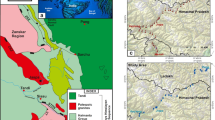Abstract
A dispersion model was used to estimate the deposition of radionuclides onto reservoirs in Hong Kong due to accidental releases from the Daya Bay nuclear power plant. If water rationing could be imposed, the radiological hazard due to ingestion of contaminated water was about 25.8 mSv/year/person. The distribution coefficients of typical reservoir soils had been measured and were found to be about an order of magnitude less than those in other countries. It was estimated that reservoir soils had the capability of reducing the effective dose equivalent to about 16.7 mSv/year/person.
Similar content being viewed by others
References
IAEA, Principles for Limiting Releases of Radioactive Effluents into the Environment. Safety Series No. 77, International Atomic Energy Agency, Vienna, 1986.
D. B. Turner, Estimates of Atmospheric Dispersion-An Introduction to Dispersion Modeling, Lewis Publishers, Boca Raton, 1994.
W. M. Leung, Assessment of the Radiological Impact to the Hong Kong Population due to Routine Atmospheric Discharges from the Guangdong Nuclear Power Plant at Daya Bay, Technical Report No. 7, Royal Observatory, Hong Kong, 1992.
B. Y. Lee,M. C. Wong,W. Y. Chan, Surface Meteorology Condition in Daya Bay 1984–1988, Technical Report No. 3, Royal Observatory, Hong Kong, 1991.
E. Koo,B. Y. Lee,C. M. Tam, Final Report of Meteorological Studies of the Junk Bay Air Shed, Occasional Paper No. 61, Royal Observatory, Hong Kong, 1984.
E. K. Garger,F. O. Hoffman,C. W. Miller, Health Phys., 70 (1996) 18.
P. H. Gudiksen,R. Lange, Nature, 327 (1987) 17.
G. A. Schmel, Atmosph. Environ., 14 (1980) 983.
A. C. Chamberlain, Fission Products Aerosols, in: P. G. C. Campbell,J. N. Galloway,R. M. Harrison (Eds), Radiative Aerosols, Cambridge University Press, Cambridge, 1991.
M. J. Clark,F. B. Smith, Nature, 332 (1988) 245.
J. T. Smith,D. R. P. Leonard,J. Hilton,P. G. Appleby, Health Phys., 72 (1997) 880.
J. T. Smith,R. N. J. Comans,D. G. Elder, Wat. Res., 18 (1999) 3672.
M. A. Shenber,A. Eriksson, J. Environ. Radioact., 19 (1993) 41.
M. Antonopoulos-Domis,A. Clouvas,S. Xanthos,D. A. Alifrangis, Health Phys., 72 (1997) 243.
C. B. Poon,S. M. Au,G. Prohl,H. Muller, Health Phys., 72 (1997) 856.
Y. H. Li,S. Gregory, Geochim. Cosmochim. Acta, 38 (1974) 703.
A. H. Devol, Deep-Sea Res., 34 (1987) 1007.
A. Stephens,F. W. Whicker,S. A. Ibrahim, J. Environ. Radioact., 38 (1998) 293.
V. P. Remez,Y. A. Sapozhnikov, Appl. Radiation Isotopes, 47 (1996) 885.
Author information
Authors and Affiliations
Rights and permissions
About this article
Cite this article
Man, C., Kwok, Y. Assessment of Risk to Hong Kong due to Accidental Releases of Radionuclides from a Nearby Nuclear Power Plant. Journal of Radioanalytical and Nuclear Chemistry 250, 485–490 (2001). https://doi.org/10.1023/A:1017949105942
Issue Date:
DOI: https://doi.org/10.1023/A:1017949105942




